The rear delt row is a compound exercise that targets the rear deltoids and upper back muscles, including the rhomboids, trapezius, and rear deltoids.
Compared to other row styles, a wider grip row pulled higher on the chest will work the rear delts more. It creates horizontal shoulder abduction combined with scapular retraction. It’s hard to say if it’s “better” than other movements.
But for me, it is a highly effective and functional exercise for building muscle and strength in the rear deltoids and upper back.
The beauty of the rear delt row lies in its adaptability. Whether you’re a gym veteran or a home workout enthusiast, there’s a version for you:
- Dumbbells Rear Delt Row: Offer excellent range of motion and unilateral focus (working one side at a time).
- Barbell Rear Delt Row: This exercise allows you to lift heavier weights, thereby boosting your overall strength.
- Cable Rear Delt Row: Provide constant tension throughout the entire movement.
- Machine Delt Row: Beginner-friendly option.
This complete guide will teach you everything you need to know about the Rear Delt Row, from biomechanics to 8 powerful variations.
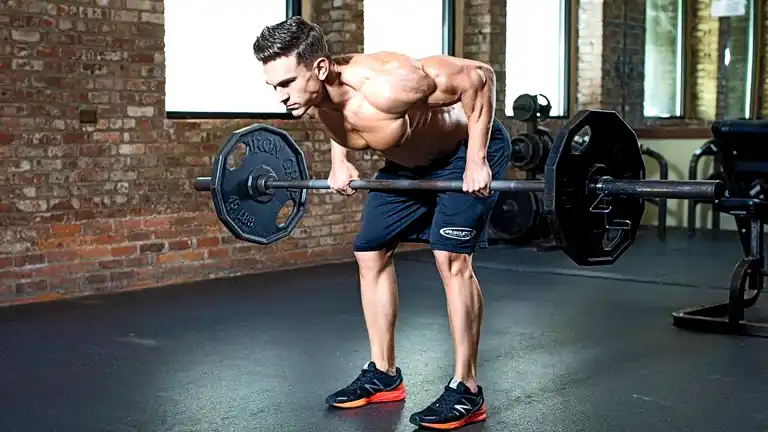
- Rear Delt Row Muscles Worked
- 8 Best Rear Delt Row Variations: From Beginner to Advanced
- 1. Single-Arm Dumbbell Row on a Bench
- 2. Chest Supported Dumbbell Rear Delt Row
- 3. Bent Over Rear Barbell Delt Row
- 4. Chest-Supported Barbell Rear Delt Row
- 5. Seated Cable Rear Delt Row
- 6. Cable Machine Rear Delt Row
- 7. Kneeling High Cable Delt Row
- 8. Chest Supported Delt Cable Row
- Best Alternatives for Rear Delt Row
- FAQs
- Do Rows Work Rear Delts
- Are rear delt rows effective?
- What muscles do Rear Delt Rows work?
- How many sets and reps should I do for Rear Delt Rows?
- Can beginners perform Rear Delt Rows?
- Are Rear Delt Rows an effective exercise for building shoulder mass?
- References
Rear Delt Row Muscles Worked
The rear delt row is a compound exercise that works many muscles simultaneously.
The main muscles worked during the barbell rear delt row are:
Secondary muscles worked during the rows:
- Latissimus dorsi,
- Biceps, brachialis
- Brachioradialis
- Infraspinatus
The muscles in the legs can be used as either dynamic stabilisers or static stabilisers.
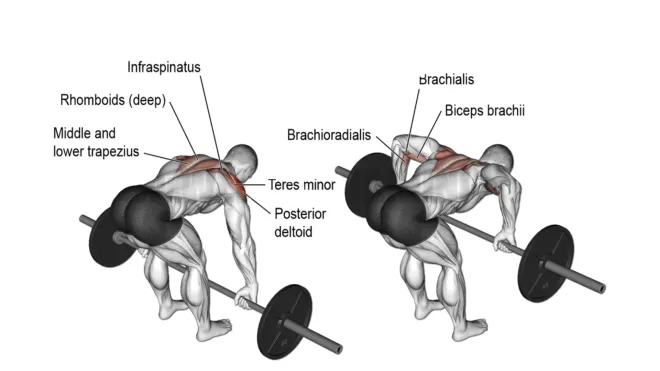
8 Best Rear Delt Row Variations: From Beginner to Advanced
Here’s how to perform the most effective variations, complete with pro-tips and common mistakes.
1. Single-Arm Dumbbell Row on a Bench
The bent-over dumbbell rear delt row is arguably the most fundamental and practical exercise for targeting rear delt. Its beauty lies in its simplicity and effectiveness. It isolates and strengthens the rear deltoids more effectively than other shoulder exercises, such as shoulder presses or lateral raises.
When you use dumbbells, you work each side separately, which helps correct strength imbalances and provides a broader range of motion.
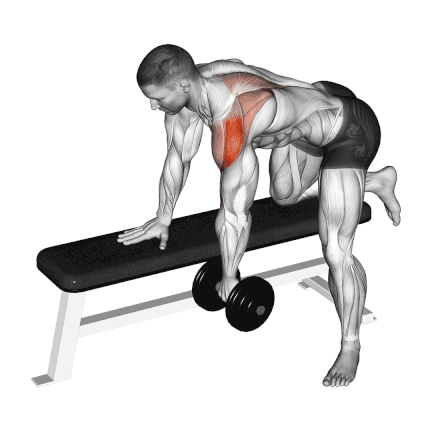
How To Do It
- Position yourself beside a flat bench. Place your left knee and left hand firmly on the bench. Your hand should be directly under your shoulder, and your knee should be directly under your hip.
- Grasp a dumbbell in your right hand with a neutral grip (palm facing the bench).
- Engage your core and flatten your back so it is nearly parallel to the floor. From your head to your hips, your spine should be in a straight, neutral position.
- Let your arm hang straight down, feeling a slight stretch. Initiate the pull by driving your right elbow up and out to the side in a sweeping, arcing motion.
- Think of pulling the dumbbell towards your armpit, not your waist. The elbow should be flared out at a 45-60 degree angle from your body.
- At the top of the movement, your elbow should be at or slightly above the level of your back. Pause for a full second and consciously squeeze your shoulder blade back and in.
- With maximum control, slowly reverse the motion. Lower the dumbbell along the same arcing path until your arm is fully extended back at the starting position.
- Switch sides and repeat.
2. Chest Supported Dumbbell Rear Delt Row
If you want to remove all guesswork and force your rear delts to grow, this is your go-to exercise. The chest-supported row is the gold standard for isolating pure muscle.
You can eliminate momentum, relieve all lower back strain, and direct all of your attention toward the target muscles by pressing your chest against a pad.
Because of this, it is a very safe and effective option for lifters of all skill levels, from novices learning the technique to experienced athletes looking for the ideal contraction.
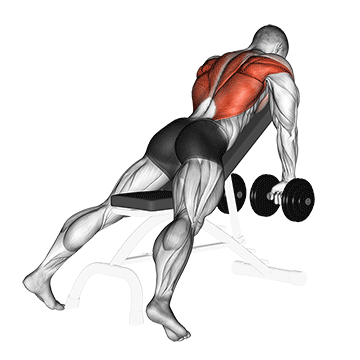
How To Do It
- Adjust an incline bench to a low angle, typically 30-45 degrees. A lower incline (closer to flat) puts more emphasis on the rear delts and rhomboids.
- Lie face-down on the bench with your chest pressed firmly into the top portion of the pad. To maintain a neutral line between your neck and spine, place your chin over the edge of the bench. Plant your feet wide on the floor to create a stable base.
- Grab the dumbbells with a neutral grip (palms facing each other) and let them hang straight down, perpendicular to the floor.
- Before you lift, retract your shoulders slightly—pull them down and back, away from your ears.
- Initiate the movement by driving your elbows up and out to the sides in a wide arc. The goal is to pull the dumbbells towards your armpits or upper chest area, not your stomach or hips. Keep your elbows flared at a 45-60 degree angle from your body.
- At the top of the movement, pause for a full second. Squeeze your shoulder blades together.
- Lower the dumbbells slowly along the same arc.
- At the very bottom, allow your shoulder blades to glide apart to get a full stretch across your upper back before starting the next rep.
Know More: 15 Best Delt Exercises For Complete Shoulder Development
3. Bent Over Rear Barbell Delt Row
The barbell variation is ideal if you want to significantly increase the size and strength of your entire upper back complex, which includes your mid-traps, rhomboids, and rear delts. Because the bar can hold more weight, it is a better tool for progressive overload.
If you haven’t tried this exercise before, load the barbell with a reasonable amount of weight, prioritising an amount that allows you to maintain proper form rather than trying to lift a heavy weight.

How To Do It
- Stand with your feet planted firmly at shoulder-width apart. Approach the barbell and grasp it with a wide, overhand (pronate) grip. Your hands should be significantly wider than your shoulders.
- Do a hip hinge by bending your knees slightly and pushing your glutes back as like you were trying to touch a wall behind you.
- Continue to hinge until your torso is nearly parallel to the floor. Maintain a neutral spine—a straight, rigid line from your head to your hips.
- Avoid the common mistake of looking up; keep your gaze on the floor a few feet in front of you.
- Brace your core and begin the pull by driving your elbows up and out towards the ceiling. As you pull, your elbows should be flared out high and away from your body. Focus on pulling the barbell towards your upper chest or collarbone area.
- At the very top of the movement, pause for a moment and squeeze your rear delts and upper back muscles as hard as possible. The bar should be close to your upper chest.
- Slowly lower the barbell back down to the starting position. A controlled 2-3 second negative is far more effective for muscle growth than simply dropping the bar.
4. Chest-Supported Barbell Rear Delt Row
A chest-supported barbell row is an effective variation. As the name suggests, it’s a row where your chest is supported.
This exercise is the best of both worlds. It combines the raw mass-building potential of a barbell with the unparalleled safety and isolation of a chest-supported movement.
This variation is an excellent choice for anyone with lower back concerns or for lifters who want to ensure their form is 100% strict.

How To Do It
- Set an incline bench to a low angle (30–45 degrees) inside a power rack.
- If you don’t have a rack, you can place the barbell on a pair of low blocks or stacked weight plates on either side of the bench. This prevents the awkward and potentially unsafe motion of trying to get into position while grabbing a bar from the floor.
- Lie face down on the bench, ensuring your chest is firmly supported and your chin is just off the top edge. Plant your feet wide on the floor for a stable base.
- Grasp the barbell with a wide, overhand (pronated) grip. Your hands should be noticeably wider than your shoulders. A wide grip is essential to shift the emphasis from your lats to your rear delts and upper back muscles.
- Pull the barbell upwards towards your upper chest. Lead the movement by driving your elbows high and wide, out towards the ceiling.
- Once the bar is near your upper chest, pause for a second and intensely squeeze your shoulder blades together.
- Return to the starting position and repeat for as many reps and sets as desired.
Know More: 25 Best Rear Delt Exercises For Mass And Strength
5. Seated Cable Rear Delt Row
The seated cable row is a phenomenal tool for developing the rear delts because it offers one significant advantage over free weights: constant tension.
The weight stack provides resistance throughout the entire range of motion—both during the pull and on the return—which is ideal for stimulating muscle growth (hypertrophy) and refining your mind-muscle connection.
This variation uses a wide grip and a high pulling path to specifically target the rear delts, rhomboids, and mid-traps, distinct from a standard lat-focused row.

How To Do It
- Attach a long straight bar or a lat pulldown bar to the seated cable row station.
- Sit down, place your feet firmly on the footpads with your knees slightly bent. Ensure that your hands are positioned several inches wider than your shoulders on each side as you hold the bar.
- Sit tall with a proud chest and a straight, neutral spine. Extend your arms fully in front of you.
- Before you begin the first rep, move your shoulder blades forward to stretch your upper back.
- Initiate the movement by driving your elbows back and flaring them out to the sides. As you pull, keep your elbows high, aiming to keep them at or close to shoulder height. Pull the bar directly towards your upper chest/collarbone area.
- As the bar comes close to your chest, pause for one full second. Squeeze your shoulder blades together as if you’re trying to pinch a pencil between them. Your torso should remain stationary; do not lean back.
- Slowly reverse the motion, resisting the pull of the cable stack.
6. Cable Machine Rear Delt Row
The unique combination of the rope attachment and the constant tension from the cable makes it one of the most effective exercises for isolating the rear delts and mid-traps.
The rope allows your hands to travel wider than a bar, promoting superior external rotation and a more intense contraction in the target muscles.
It is usually performed for moderate to high reps, at least 8–12 reps per set, as part of an upper-body or shoulder-focused workout.
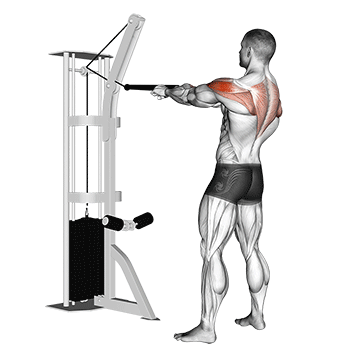
How To Do It
- Set a cable pulley to mid-chest height. A higher anchor point turns this into a face pull (targeting external rotators more), while a lower anchor point engages more lats. Mid-chest height is the sweet spot for the rear delts.
- Attach a double-grip rope handle.
- Grasp the rope with an overhand grip (palms facing the floor). Take a few steps back to create tension in the cable.
- Stand with your feet shoulder-width apart in a staggered or square stance, with a slight bend in your knees.
- Extend your arms straight out in front of you. Allow the weight to pull your shoulder blades forward (protraction) to get a good stretch across your upper back.
- Pull the rope’s ends apart and drive your elbows back to start the movement. Keep your elbows high—at or just below shoulder level. Pull until your hands are on either side of your chest.
- At the peak of the movement, with your hands beside your chest, pause for a second. Actively squeeze your shoulder blades together.
- Slowly return the rope to the starting position.
7. Kneeling High Cable Delt Row
This exercise is a true functional powerhouse, often prescribed by physical therapists and top coaches for improving shoulder health and posture. The half-kneeling stance isn’t just for show; it’s a diagnostic tool that locks your pelvis and core, preventing you from using your lower back to cheat.
It is a tremendous exercise that effectively works many muscles, including the shoulder, back, wing, and trapezius muscles.
Besides that, it is one of the most effective corrective exercises that help compensate for poor posture and shoulder dysfunction.
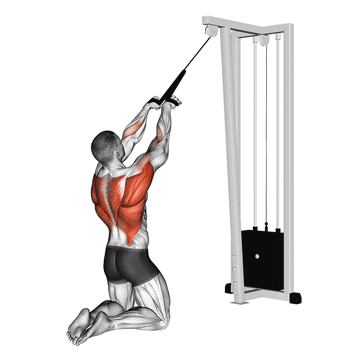
How To Do It
- Set a cable pulley to its highest or near-highest position and attach a rope handle.
- Step back and get into a half-kneeling position, with one knee on the floor and the other foot planted in front.
- Before you even grab the rope, get stable. Squeeze the glute of your back leg and brace your core. This locks your pelvis in a neutral position and prevents your lower back from arching.
- Grasp the rope with an overhand (palms down) grip. Extend your arms fully towards the anchor point.
- Start the pull by driving your elbows back and up. As you pull, simultaneously spread the rope apart, aiming to bring your hands towards your ears or the sides of your face.
- Squeeze your shoulder blades together for a brief moment at the end of the movement.
- Slowly reverse the motion, resisting the cable’s pull. Before starting the next rep, let your arms reach out to their full length and feel the stretch across your upper back.
- Complete all reps on one side before switching to your kneeling stance and repeating.
8. Chest Supported Delt Cable Row
The chest-supported cable delt row is performed on a weighted horizontal cable machine with a bench.
It is an excellent compound exercise for developing the middle and upper back, and it offers useful arm work.
The chest-supported row can be performed with different grip positions and using different angles and attachments.
- Underhand grip
- Single-arm high row
- Rope attachment,
- Long bar
- Double arm low row….. Get creative!
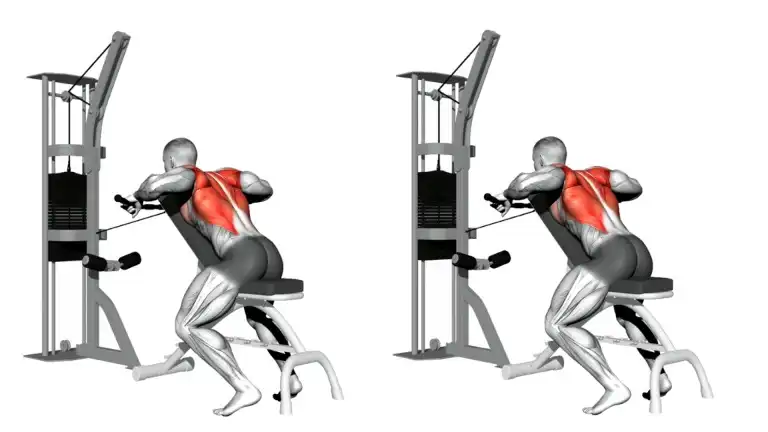
How To Do It
- Attach a rope handle to a cable setup.
- Adjust an incline bench to between 30–45 degrees and place it in front of the cable machine.
- Sit on the bench with your chest against the backrest. Grip the handles and extend your arms.
- Pull your shoulders down and back and brace your core.
- Bend your arms and pull the handles in toward your lower ribs.
- Lead with your elbows, keep your wrists straight, and squeeze your shoulders together.
- Smoothly extend your arms, let your shoulders shrug forward to stretch your upper back, retract your shoulders again, and repeat.
Know More: Guide To Mastering The Cable Row: Benefits, Form, Variations
Best Alternatives for Rear Delt Row
Working your delts can be achieved through various exercises; we will mention a very popular alternative exercise – one that you can do alongside or instead of the regular rear delt row.
Before we explore the best rear delt row alternatives. We must remember that a good delt row alternative will be able to satisfy the following criteria:
- Activate the rear muscle groups trained in the rear delt row.
- Isolate the muscle groups during execution.
- Train the rear delt muscle through a longer range of motion
These alternatives might work better for you.
- Face Pull
- Renegade Row
- Seated Rear Delt Fly
- Machine Rear Delt Fly
- Rear Delt Cable Fly
- Landmine Row
- Upright Row
FAQs
Do Rows Work Rear Delts
Yes, rows do work rear delts, but the degree of their involvement depends on a few factors, such as row type, form and Grip.
- Wide Grip: Generally, a wider grip will work your rear delts and traps more than a narrower grip.
- Elbow Path: Keep your elbows flared out during the row to actively target those rear delts.
- Traditional Bent-Over Rows (Barbell or Dumbbell): These exercises target the rear delts significantly, along with other upper back muscles, including the lats, rhomboids, and traps.
- Chest-Supported Rows: Offer more specific rear delt isolation since they minimise torso and lower back involvement.
Are rear delt rows effective?
Whether you use dumbbells, barbells, or cables for rear delt rows, all are highly effective for training your upper back and shoulder muscles. It primarily works your rear delts, which are small muscles on the back of your shoulders.
What muscles do Rear Delt Rows work?
Rear delt rows primarily work the rear deltoid muscles.
However, they also work other muscles, such as the middle trapezius, rhomboids, and rotator cuff muscles.
How many sets and reps should I do for Rear Delt Rows?
Aim for 3–4 sets of 8–12 reps per set. You can also adjust the weight and reps to challenge yourself.
Can beginners perform Rear Delt Rows?
Yes, beginners can perform rear delt rows, but it’s essential to start with a lighter weight and focus on proper form.
Are Rear Delt Rows an effective exercise for building shoulder mass?
Yes, Rear Delt Rows are an effective exercise for building shoulder mass, particularly in the rear deltoid muscles.
References
- Campos YAC, Vianna JM, Guimarães MP, et al. Different Shoulder Exercises Affect the Activation of Deltoid Portions in Resistance-Trained Individuals. J Hum Kinet. 2020;75:5-14. Published 2020 Oct 31. doi:10.2478/hukin-2020-0033
- Ronai, Peter MS, CSCS, RCEP: Exercise Modifications and Strategies to Enhance Shoulder Function. Strength and Conditioning Journal: August 2005 – Volume 27 – Issue 4 – p 36-45
- Botton C, Wilhelm E, Ughini C, Pinto R, Lima C. Electromyographical analysis of the deltoid between different strength training exercises. Med Sport. 2013;17:67–71
- Franke AR, Botton C, Rodrigues R, Pinto R, Lima C. Analysis of anterior, middle and posterior deltoid activation during single and multijoint exercises. J Sports Med Phys Fitness. 2015;55:714–721.

Manish is a NASM-certified fitness and nutrition coach with over 10 years of experience in weight lifting and fat loss fitness coaching. He specializes in gym-based training and has a lot of knowledge about exercise, lifting technique, biomechanics, and more.
Through “Fit Life Regime,” he generously shares the insights he’s gained over a decade in the field. His goal is to equip others with the knowledge to start their own fitness journey.
